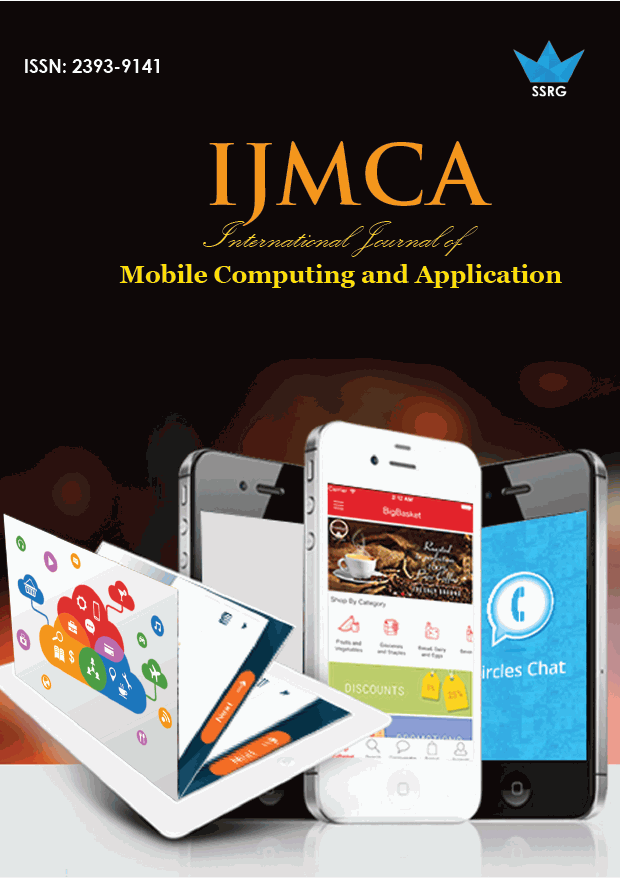Wireless Sensor Network Based on Reduced Packet Loss with Maximum Clusters

| International Journal of Mobile Computing and Application |
| © 2015 by SSRG - IJMCA Journal |
| Volume 2 Issue 2 |
| Year of Publication : 2015 |
| Authors : Dr.J.Amitava and T. Anil |
How to Cite?
Dr.J.Amitava and T. Anil, "Wireless Sensor Network Based on Reduced Packet Loss with Maximum Clusters," SSRG International Journal of Mobile Computing and Application, vol. 2, no. 2, pp. 1-5, 2015. Crossref, https://doi.org/10.14445/23939141/IJMCA-V2I3P102
Abstract:
Nowadays it is a known thing that wireless sensor network is one of the wide rising field in which the sensornodes are arranged in order to receive and forward the composed from other nodes in the network. The thought of mobility ofnodes is bit disadvantageous. Since they will consume more energy in order to communicate the data to the base station if it islocated far from the nodes. In this paper the mobility of nodes is measured which mainly works on cost value in terms onenergy. Thus it is possible to form more number of nodes in the network. In every cluster, cluster head will transmit the datafrom nodes to base station which is away from the nodes of the network.
Keywords:
Wireless Sensor Network; Clusters; Energy Efficiency; Mobility; PDR
References:
[1] K. Padmanabhan , Dr. P. Kamalakkannan,“Energy Efficient Adaptive Protocol for Clustered Wireless Sensor Networks” IJCSI International Journal of Computer Science Issues, Vol. 8, Issue 5, No 1, September 2011 ISSN (Online): 1694-0814.
[2] I. F. Akyildiz, W. Su, Y. Sankarasubramaniam, and E. Cayirci, “A Surveyon Sensor Networks,” IEEE Communications Magazine, vol. 40, no. 8,pp. 102–114, Aug 2002.
[3] Wireless Sensor Networks In Proceedings of the 33rd Annual Hawaii International Conference on System Sciences (HICSS), 3005±3014, Big Island, Hawaii, USA, January 2000.
[4] V. Loscri, G. Morabito, and S. Marano, A Two-Level Hierarchy for Low-Energy Adaptive Clustering Hierarchy, DEIS Department, University of Calabria.
[5] A. Manjeshwar and D. P. Agrawal, TEEN: A Protocol for Enhanced Efficiency in Wireless Sensor Network 1st international Workshop on Parallel and Distributed Computing Issues in Wireless Networks and Mobile Computing, 2001, p.189.
[6] A. Manjeshwar and D. P. Agrawal, APTEEN: A Hybrid Protocol for Efficient Routing and Comprehensive Information Retrieval in Wireless Sensor Networks, 2nd International Workshop on Para
[7] llel and Distributed Computing Issues in Wireless Networks and Mobile Computing, 2002, 195-202.
[8] M.Ye,C.Li,G.Chen and J.Wu,EECS:An Energy Efficient Clustering Scheme in Wireless Sensor Networks, National Laboratory of Novel SoftawareTechnology,NanjingUniversity,China.
[9] O. Younis and S. Fahmy, “HEED: A Hybrid Energy-Efficient Distributed Clustering Approach for Ad Hoc Sensor Networks,” IEEE Transactions on Mobile Computing, vol. 3, no. 4, Oct-Dec 2004.
[10] S. Bandyopadhyay and E. J. Coyle, “An Energy Efficient Hierarchical Clustering Algorithm for Wireless Sensor Networks,”IEEEINFOCOM,April 2003
[11] S.M.Jung ,Y.J.Han, and T.M.Chung “The Concentric Clustering Scheme for Efficient Energy consumption in the PEGASUS 9th International Conf. on Advanced Communication Technology, vol.1, pp.260-265, Feb. 2007.
[12] W.R.Heinzelman,A.Chandrakasan, and H.Balakrishnan “Energy Efficient Communication Protocol for Wireless Sensor Networks” .

 10.14445/23939141/IJMCA-V2I3P102
10.14445/23939141/IJMCA-V2I3P102